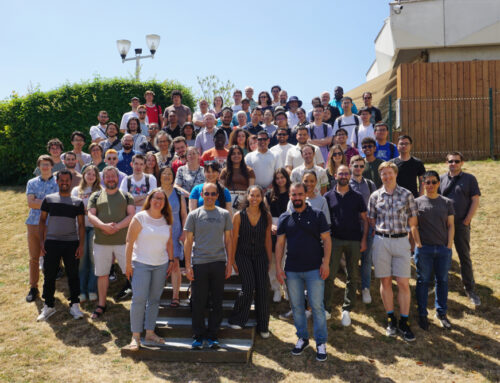Eslam ABOUSELIMA soutient sa thèse de doctorat le vendredi 10 juin 2022, 9h sur le site Pelvoux, amphithéâtre Bx30. Une retransmission via Zoom est également effectuée.
Titre : Fault-Tolerant Control and Path Planning for Quasi-LPV Systems: Application to Quadrotor
Keywords : LPV – fault-tolerant control – fault detection and diagnosis – quadrotor – aircraft modelling – modelbased observer – PID – H∞ control – LQG – H− norm.
Abstract :
Recently, the autonomous systems are getting more and more popular and are widely deployed in several applications in our daily life. That’s why a great concern has been dedicated for the problem of autonomous systems fault-tolerant control (FTC). As if the system is provided with a FTC unit, it will be able to create an alert in case of system malfunction while preserving an acceptable performance to complete the required task. Evidently, the UAVs are among the systems that are in need for such FTC algorithms because any system malfunction can cause a severe damage not just for the vehicle itself but for the surrounding environment as well. So this work is investigating the problem of designing a FTC algorithm for a quadrotor aiming to be a worthy contribution to the evolution of UAVs safety and reliability.
Such a problem is tackled through some fundamental steps beginning with establishing a trustful model for the system representing the physical dynamics accurately. So Newton-Euler formulation is used for modeling the quadrotor resulting in a mathematical model that describes the relation between the applied forces and the system states. The obtained model is then linearized around the hovering point using small disturbance theory, but as the resulting model is excessively simplified some other propositions are investigated. One suggestion is to assume constant value for the nonlinear terms in the attitude loop instead of neglecting them. However, the second method adopted is appealing as the system is modeled in an LPV framework where the nonlinear terms are considered as linearly time varying within the given parameter limits. The deduced model is then used to build a controller that stabilizes the quadrotor and guarantees an adequate trajectory tracking. So initially a PID control law is designed for the simplified linear model using transfer function loop shaping technique to satisfy the required H∞ norm characteristics. A linear quadratic Gaussian (LQG) control scheme is proposed in state space form as an optimal controller that penalizes the control action according to the actuators limitations, besides recovering the system states whose measurements are affected by Gaussian white noise.
Then to ensure the effectiveness of the controller in wide areas of application where the surrounding environmental conditions are not guaranteed to be exactly modeled a robust controller based on H∞ technique is designed for the proposed LPV system. The simulation results shows great enhancement for the performance while the system is subjected to unknown exogenous disturbances and measurement noise. In order to provide the quadrotor with an efficient FTC scheme, first, a fault detection and diagnosis (FDD) unit is proposed to identify the type, amount, and location of the existent fault. The FDD unit contains a model-based observer that generates some residual signals indicating the fault occurrence. According to the observer design it may give just fault detection with a bank of observers for fault isolation or it can perform fault detection, estimation, and identification simultaneously. So an observer is designed based on H−/H∞ technique aiming at maximizing the fault to residual sensitivity by using the H− index properties, and minimizing the H∞ norm for worst case exogenous signals attenuation. The effectiveness of such an observer in actuator fault detection is demonstrated by applying it to a quadrotor model and comparing the resulting residuals with those obtained from a Kalman filter.
Afterwards, a new approach is proposed for observer design based on an auxiliary output containing the system output and its successive time derivatives. This approach is used for both actuators and sensors fault diagnosis including fault detection, estimation, and isolation. It is illustrated that under some structural conditions, the faults can be estimated exactly while the perturbations are completely decoupled from the residual signals. However, if exact convergence is not ensured, some relaxed conditions are provided to maintain asymptotic fault estimation.
Finally, the worst-case where the perturbations cannot be decoupled is presented and handled using H−/H∞ approach which is further enhanced utilizing the auxiliary output. A general design procedure is provided which unifies the presented different cases according to the system output relative degree, then applied in simulation to a quadrotor model to illustrate the effectiveness of the proposed approach. Upon the obtained results from the actuator FDD unit an active fault-tolerant control law is designed. After fault evaluation the FDD gives a decision for the controller reconfiguration unit whether the actuator damage can be contained or not. For the first case, a control law is proposed aiming at fault compensation and precise trajectory tracking in the presence of system malfunction. For the later case a fail safe mode is used to ensure that the quadrotor can land safely without crashing or causing a harm to the surrounding environment.
Thesis Objectives
• Creating a quadrotor model influenced by the nature of its operational environment while
representing its dynamics.
• Designing a control law that can stabilize the drone, hence achieve trajectory tracking.
• Introducing a powerful fault diagnosis unit capable of identifying adequately the location,
magnitude, and type of fault.
• Outlining a controller reconfiguration unit flexible enough to utilize the results of fault diagnosis efficiently.
• Ensuring a robust link between the two units that guarantees an effective FTC scheme.
• Applying the proposed FTC scheme on a drone and test its performance while being subjected
to different faults scenarios.
List of publications
[1] Eslam Abouselima, Dalil Ichalal, and Saïd Mammar. Quadrotor control and actuator fault
detection: Lqg versus robust H−/H∞ observer. In 2019 4th Conference on Control and Fault
Tolerant Systems (SysTol), pages 86–91. IEEE, 2019. HAL https://hal.archives-ouvertes.fr/IBISC/hal-02415879v1
[2] Eslam Abouselima, Dalil Ichalal, and Said Mammar. Robust actuator fault diagnosis for lpv
systems: Application to quadrotor. In 2021 American Control Conference (ACC), pages 4938–
4945. IEEE, 2021. HAL https://hal.archives-ouvertes.fr/IBISC/hal-03320147v1
Composition du jury de thèse
| Membre du jury | Titre | Lieu d’exercice | Fonction dans le jury |
|---|---|---|---|
| Mohamed DJEMAI | Professeur des Universités | LAMIH, Valenciennes, Institut Hauts de France | Rapporteur |
| Dalil ICHALAL | Professeur des Universités | Université d’Évry, Université Paris-Saclay | Co-directeur de thèse |
| Saïd MAMMAR | Professeur des Universités | Université d’Évry, Université Paris-Saclay | Directeur de thèse |
| Rodolfo ORJUELA | Maître de Conférences HDR | MIAM, Université de Haute-Alsace | Rapporteur |
| Siham TEBANI | Professeure | CentraleSupélec | Examinatrice |
| Alessandro VICTORINO | Maître de Conférences HDR | Heudiasyc, Université de Technologie de Compiègne | Examinateur |
- Date : vendredi 10/06/2022, 10h
- Lieu : Site Pelvoux, Amphithéâtre Bx30, Une retransmission via Zoom est également effectuée.
- Doctorant : Eslam ABOUSELIMA, Université d’Évry, Université Paris Saclay, IBISC équipe SIAM
- Directeur de thèse : Saïd MAMMAR (PR Univ. Évry, IBISC équipe SIAM)
- Co-directeur de thèse: Dalil ICHALAL (PR Univ. Évry, IBISC équipe SIAM)
- Consulter le document de thèse sur HAL






